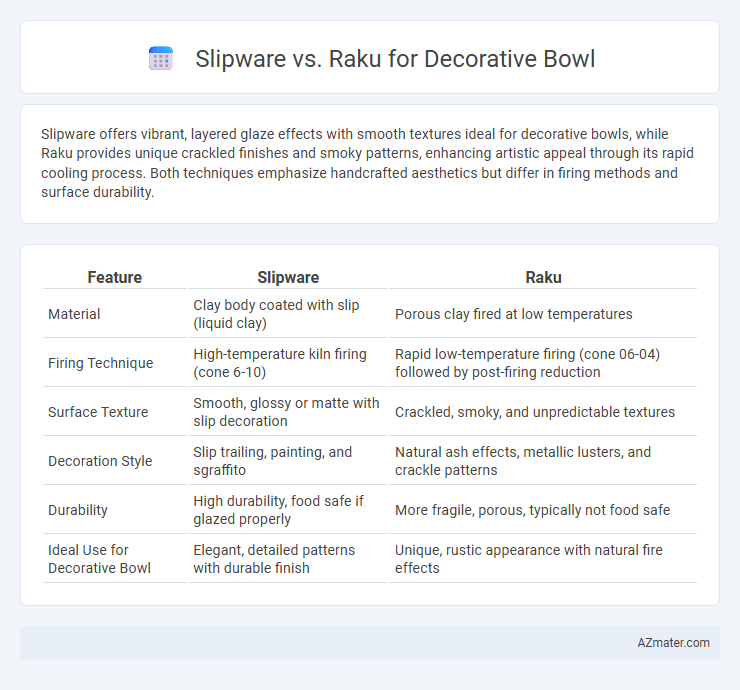Slipware offers vibrant, layered glaze effects with smooth textures ideal for decorative bowls, while Raku provides unique crackled finishes and smoky patterns, enhancing artistic appeal through its rapid cooling process. Both techniques emphasize handcrafted aesthetics but differ in firing methods and surface durability.
Table of Comparison
| Feature | Slipware | Raku |
|---|---|---|
| Material | Clay body coated with slip (liquid clay) | Porous clay fired at low temperatures |
| Firing Technique | High-temperature kiln firing (cone 6-10) | Rapid low-temperature firing (cone 06-04) followed by post-firing reduction |
| Surface Texture | Smooth, glossy or matte with slip decoration | Crackled, smoky, and unpredictable textures |
| Decoration Style | Slip trailing, painting, and sgraffito | Natural ash effects, metallic lusters, and crackle patterns |
| Durability | High durability, food safe if glazed properly | More fragile, porous, typically not food safe |
| Ideal Use for Decorative Bowl | Elegant, detailed patterns with durable finish | Unique, rustic appearance with natural fire effects |
Introduction to Slipware and Raku
Slipware features a decorative technique where liquid clay slip is applied to pottery before firing, creating intricate patterns and textures suited for ornamental bowls. Raku, a traditional Japanese firing process, involves rapid heating and cooling, producing unique crackled surfaces and unpredictable color variations that enhance artistic expression. Both methods emphasize tactile aesthetics and heritage craftsmanship, ideal for creating visually striking decorative bowls.
Historical Background of Slipware
Slipware, originating from ancient Mediterranean pottery traditions, utilizes liquid clay (slip) to create intricate designs on earthenware, dating back to at least the Bronze Age. This technique gained prominence in medieval Europe, especially during the 16th and 17th centuries, where slip-decorated bowls were highly valued for both functional and ornamental purposes. In contrast, Raku pottery emerged in 16th-century Japan as a hand-shaped, low-fired ceramic process connected to the tea ceremony, emphasizing spontaneity and natural aesthetics, making slipware historically significant for its detailed, crafted decoration in decorative bowls.
Origins and Evolution of Raku Pottery
Raku pottery originated in 16th-century Japan, initially crafted for traditional tea ceremonies, characterized by rapid firing and cooling techniques that create unique glaze effects and textures. Unlike slipware, which uses slip decoration applied before firing to achieve intricate patterns and surface designs, raku emphasizes spontaneity and unpredictability in its firing process, often involving removal from the kiln while hot and rapid cooling in open air or combustible materials. The evolution of raku pottery has influenced contemporary decorative bowls worldwide, blending ancient Japanese aesthetics with modern artistic interpretations, whereas slipware remains rooted in slip application traditions from Europe and Asia.
Key Material Differences: Clay and Glazes
Slipware decorative bowls use a clay body coated with a liquid clay slip that allows for intricate painted designs and vibrant surface textures, often fired at lower temperatures. Raku bowls employ a porous, often grogged clay body specifically formulated for rapid cooling during the raku firing process, resulting in crackled and smoky glaze effects unique to this method. Glazes in slipware are typically lead or tin-based for bright, opaque finishes, while raku glazes are formulated to react with thermal shock and reduction atmospheres, producing metallic lusters and unpredictable surface patterns.
Firing Techniques: Slipware vs Raku
Slipware firing involves a controlled oxidation process at mid-range temperatures, enhancing the clay body's durability and emphasizing the decorative slip's color contrast. Raku firing, by contrast, utilizes rapid heating and immediate removal from the kiln followed by reduction in combustible materials, creating unique crackle patterns and metallic effects on the decorative bowl's surface. These distinct firing techniques directly influence the aesthetic qualities and structural properties of slipware and raku ceramics.
Surface Decoration Styles Compared
Slipware features surface decoration using liquid clay slips applied through techniques like trailing, marbling, or sgraffito, creating intricate patterns with contrasting colors that emphasize texture and traditional craftsmanship. Raku decoration relies on rapid firing and reduction cooling which produces unpredictable crackle glaze effects, metallic sheens, and smoke-imprinted patterns that emphasize organic, spontaneous aesthetics. Slipware's controlled surface designs contrast with Raku's unique, fiery finishes, offering distinct visual and tactile qualities for decorative bowls.
Distinctive Color and Texture Outcomes
Slipware offers rich, layered textures with its fluid, hand-applied slip creating organic, earth-toned surfaces ideal for rustic decorative bowls. Raku firing achieves unpredictable, crackled textures and vibrant metallic or smoky hues, making each bowl uniquely reflective of the firing process. Choosing between Slipware and Raku depends on whether the desired aesthetic prioritizes controlled, textured color layering or spontaneous, dynamic surface effects.
Durability and Practicality for Decorative Bowls
Slipware offers high durability due to its thick slip coating that creates a hard, protective surface resistant to scratches and stains, making it ideal for decorative bowls meant to last. Raku pottery, while prized for its unique crackled glaze and aesthetic appeal, tends to be more fragile and porous, requiring careful handling and limited exposure to moisture. For practical decorative bowls that combine beauty with long-lasting strength, slipware is generally the preferred choice over raku.
Artistic Trends and Contemporary Uses
Slipware techniques in decorative bowls emphasize intricate surface textures and vibrant glazing patterns, reflecting a resurgence in handmade, artisanal pottery trends favored by contemporary ceramic artists. Raku pottery, prized for its unpredictable crackle effects and smoky finishes, aligns with modern aesthetic preferences for organic, wabi-sabi-inspired decor that celebrates imperfection and spontaneity. Both mediums are increasingly popular in gallery exhibitions and boutique interiors, showcasing innovative blends of traditional craft with avant-garde artistic expressions.
Choosing the Right Technique for Decorative Bowls
Slipware offers rich, textured surfaces with intricate patterns using colored liquid clay, ideal for creating traditional and rustic decorative bowls. Raku firing provides unique crackled finishes and unpredictable effects, perfect for modern, artistic bowls with a distinctive aesthetic. Selecting the right technique depends on whether you prefer the controlled, detailed designs of slipware or the spontaneous, dramatic results from Raku firing.

Infographic: Slipware vs Raku for Decorative bowl
 azmater.com
azmater.com